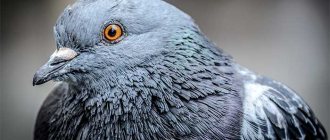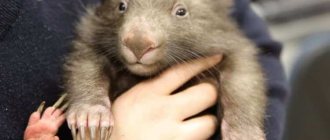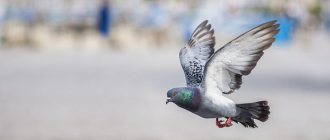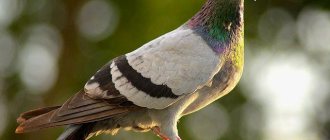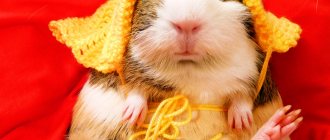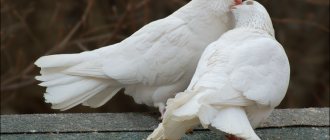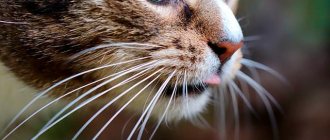There are a huge number of lovers of beautiful birds called pigeons all over the world. These are beautiful ornamental birds that delight not only with their beautiful plumage, but also with their ability to fly quickly. Have you ever wondered how many pigeons there are in the world?
Reference. Scientists believe that people managed to tame these birds about 5 centuries ago. Since that time, many different breeds have been bred, which differ from each other not only in plumage, but also in body shape and habits.
general characteristics
Pigeons are small birds that, depending on the variety, can grow from 15 to 75 cm. Their weight varies from very small (about 30 grams) to large - 3 kg. The birds' physique is quite muscular and strong. Their neck is short and their head is small. In comparison, the wings are quite long and wide-opening. The flight feathers are round at the ends.
City pigeons, which are most often encountered by people, usually measure about 35 cm and weigh up to 40 grams.
The tail is also quite long and grows in proportion to the body. It can be sharp, round or wide. Pigeons usually have about 13 tail feathers, but in crowned varieties this number can reach 18 feathers.
The beak of pigeons is usually short, but sometimes is of medium length. It is straight and thin, with a widening at the base.
Pigeons do not have pronounced sexual dimorphism: males and females do not differ in color or other external characteristics. Moreover, males are slightly larger than females. However, in some tropical bird species, the males have brighter colors.
The plumage of the birds itself is quite thick, it fits tightly to the body and combines several shades. Birds are very diverse, so color options may vary depending on their habitat. So, they can be single-colored (gray, yellow, white, etc.), variegated, or have a pattern on the plumage.
The paws of pigeons are four-toed, which makes them extremely convenient for terrestrial movement. The legs are quite short: three toes are located in front, one is behind. This helps pigeons move easily on the ground, which distinguishes them from, for example, sparrows, which have to move by jumping.
Due to their anatomical structure, pigeons are capable of reaching high speeds - more than 130 km/h. Even ordinary birds found in the city are considered strong and hardy. They fly at a speed of about 70 km/h. With such a flight, birds are able to cover significant distances, approximately 300 km per day.
Bright birds
The red breed of pigeons lives in America. Basically, these are savannas, the shores of lakes and rivers, where there is little vegetation. The color of the feathers can be called purple-brown, and in the neck area there is a greenish tint. Females have slightly paler plumage. The length of the bird reaches 32 cm, and the largest individual in the history of the species weighed 340 g.
Among the colored varieties, undoubtedly, one must include the pink pigeon from the south of Mauritius. This is a state in East Africa that includes several islands. In nature, the cooing flyer is very rare and is listed in the Red Book. For a long time this bird lived in nature reserves.
Its size reaches 37 cm in length, but the head and neck are small. Particular attention should be paid to the color, the main color of which is pale pink. This bird cannot be compared with artificially colored bright specimens.
In the article “Pink Pigeons” you will learn all the details about this breed.
The green dove has yellow, brown and olive shades in its plumage. Habitat - Africa and South Asia, and in Russia - the Far East. In terms of physique, the bird resembles an ordinary gray pigeon, and only its bright color gives it away as a different breed.
Where do pigeons live in the wild?
The habitat of pigeons is extremely wide. These birds are not found only at the North and South Pole. This widespread distribution is due to a high level of adaptation, which allows them to be found both in urban environments and in forests, fields and even deserts. Wild birds are found at altitudes of up to 5 thousand meters.
Egyptian turtle dove
Rock pigeons are common human companions, found in many countries of the world, including Russia. They are found everywhere: in parks, residential buildings, squares, etc. Pigeons living in such conditions skillfully adapt to urban space and walk on the ground more often than their wild comrades.
Approximately 60% of pigeons inhabit islands and do not inhabit continents.
Psychology
The psychology and intelligence of pigeons is much more complex and deeper than people are used to thinking. They have amazing relationships and interactions in their community. For example, they are able to find a compromise solution that will suit everyone in a problematic situation. This was established during an experiment where the birds were allowed to return to the house alone or together. They preferred to change the route so that the maximum time could be spent flying in a way that was less convenient for everyone, but equally suitable for everyone.
They also demonstrate superstitious behavior. Back in the last century, a study was published in which two specimens were placed in a cage, where they were periodically given grain. During the experiment, it was noticed that six of the eight behaved strangely: one periodically stuck his head into the corner of the cage, the second sometimes began to walk around the cage clockwise, etc. In the course of research, it was possible to establish that birds believe that special behavior can speed up the delivery of food. In humans, this behavior is called “superstition.”
In both sexes of this species, intelligence is developed differently: males are usually smarter, and females are more loyal.
In addition, they are able to identify their reflection in the mirror. Besides them, only animals with a high level of intelligence show this feature: dolphins, elephants, orangutans and chimpanzees. A person reaches this level of development only at 1.5 years.
These birds surprised us with their abilities in the field of mathematics. They clearly showed that they are characterized by analytical thinking and the construction of cause-and-effect relationships. During the experiment, pigeons were shown three sets of objects of different shapes and colors on a display. The first set had one item, the second had two, and the third had three. The birds had to peck at the sets in increasing order of the number of items they contained. When the number of sets and the number of objects they contained increased to 9, the birds easily completed the task correctly, although people did not explain to them that there could be a larger number after 3 objects. This made it possible to understand that pigeons are very highly trainable and understand the abstract nature of numbers.
What does a pigeon eat in the wild?
The pigeon diet is based on various objects of plant origin. They include leaves, seeds, and fruits of various trees. Typically, pigeons swallow the fruits along with the seeds, which they then regurgitate. Sometimes pigeons feed on small invertebrates, but this happens quite rarely. These usually include worms and small insects.
Pigeons are one of the most unpretentious birds when it comes to food. This is explained by the poor development of taste sensations. If a person has about 10 thousand taste buds, then pigeons have only 37. Therefore, all the food they receive seems to taste almost the same.
Birds living in the city often find food in landfills, next to garbage. In addition, people often feed birds, especially often during the cold season. Birds quickly get used to this way of interacting with people, remember the places where they are fed, and fly there.
Typically, tamed birds are fed grain, porridge and herbs. Their favorite treats are yellow peas, raw seeds, and crushed nuts.
Pigeons, unlike other birds, draw in water as if using a straw. Other birds usually simply catch the drops in their beaks and raise their heads to help the water drain. In the wild, birds often need to travel long distances to find bodies of water.
Plumage
In addition to the usual gray plumage, there are species with amazing bright colors: blue, green, red, yellowish. Such representatives are found not in our latitudes, but where lush greenery blooms - in the tropics and subtropics. A bright appearance is needed in order to become noticeable against the background of bright foliage. In the ranking of representatives with the most beautiful plumage, the leading places are occupied by the Asian fruity and sensitive pigeon with bright spots on the chest. They use these spots as a signal to identify their relatives and scare away natural enemies.
The scales on pigeon feathers are arranged in such a way that they can smooth out sharp air currents during flight. In terms of rigidity and smoothness, their plumage can compete with many other migratory birds. In some species it has a structure that allows it to fly at such a low speed that any other species would already fall. From the outside it may seem as if a dove is hovering in the sky. While lingering in the air, they can see everything far below.
There is an amazing subspecies whose feathers allow them to make specific sounds as air currents pass through them. With the help of this “singing” they can communicate with each other.
An adult male or female may have about 10 thousand feathers on its body. If this indicator decreases sharply, it means the bird is sick.
Lifestyle and behavioral characteristics
Wild pigeons choose areas to live that are located on the banks of rivers, near coastal cliffs or mountains. Birds also often settle in cities and are easily domesticated, since people have used their capabilities for a long time.
Most species are sedentary birds. They show their main activity in the daytime. While in search of food, wild birds can fly from place to place until the sun sets. However, in urban environments, activity continues in the evening, when twilight sets in.
Wild birds, going in search of food, can travel a distance of about 50 km from the nest.
At night, pigeons usually sleep, but before that they try to drink water at night. It is much easier to find water in the city, so the birds here are more relaxed. Females usually sleep in the nest, while males are located somewhere near their partner. They protect their home and sleep lightly until dawn.
Question to the expert
How long is the lifespan of a pigeon?
Accurately estimating the lifespan of avian species can be difficult. This is due to the fact that some individuals become victims of feathered and terrestrial predators, or die from natural causes associated with lack of food or disease. In the wild, they can last no more than 3 years. However, there are more optimistic statistics. Most birds live to be 20 years old, which is the average lifespan of pigeons. At the same time, there are also real long-livers. Some varieties can live more than 30 years.
Social structure
Pigeons are flocking birds. They unite in groups not because of mutual sympathy, but because of the benefits that the birds receive when they jointly search for water, food and protection from enemies. When the flock is on the ground, its members are usually left to their own devices. However, during flights, leaders appear who set the direction for the entire flock and control its movement.
Pigeons communicate with each other by calling, cooing and flapping their wings. Cooing can be flirting, frightening, made while eating, or attracting attention.
Home of the pigeons
Recommended by topic
Blackbirds Woodpecker Heron
The habitat of pigeons differs based on their habitat. Birds can build their nests in places such as:
- Secluded recesses in the rocks.
- Small hollows in the forest.
- Tree branches.
- Thickets of bushes near the water.
- Abandoned buildings.
In urban environments, pigeons usually choose for nesting:
- Attics.
- Balconies and cornices.
- Roofs.
Pigeons build nests responsibly, since this place becomes a breeding ground.
Bird from Germany
The German pigeon is very popular all over the world. This postal breed appeared thanks to the work of German livestock specialists. In addition to excellent sporting qualities, it also has decorative features. And, above all, it is the color of the feathers. However, it should be clean and uniform throughout the body, possibly with a shine.
The piebald pigeon can be spotted or brindle, but it is mandatory to have colored and white feathers in large quantities. There are individuals with black or white belts, with specks on the scutes, and dark scales. The shades of the inclusions depend on the overall color.
The breed generally has a very diverse palette of colors:
These birds are otherwise called German show birds.
One should not lose sight of such a bright breed as the Belgian pigeon. Its color is very rich. Brown, yellow, pale blue and blue-gray birds are found.
We tried to tell you about the most prominent representatives of the pigeon family. If you liked the article and found it useful, please like it.
Write comments on the topic of colorful pigeons and their features.
ptitsadoma.ru
Character and habits of pigeons
Males most often display quite warlike behavior and often get into fights over females. They court the doves for a long time, and then defend the territory assigned to them and negatively greet all competitors. At the same time, females do not always respond favorably to the advances of potential partners. If they already have a mate, ladies will turn down potential suitors, as pigeon couples are usually monogamous.
Weak males yield to stronger ones and try to avoid direct confrontation.
The pigeons themselves are usually loud, combative and quite abrupt. They are active both in relationships with their relatives and with people, not being afraid to take food from their hands or build nests near residential buildings.
Interaction with people
People have a long history with pigeons. Previously, it was these birds that were responsible for mail and were chosen for the quick delivery of letters. In addition, pigeons were often mentioned in the Bible and the mythology of various peoples. They were considered birds carrying important messages that could change people's lives.
Today, people usually breed decorative pigeons in specially designated areas. Thanks to their centuries-long history of interaction, birds are highly trainable and have a developed sense of home, which helps them return to the same place.
Dovecote
Pigeons are not migratory birds. However, they are well oriented by the sun and use smells and magnetic fields as landmarks. Birds are able to fly up to 1000 km from their home and then return back.
Birds also sense infrasound well, which makes them sensitive to the approach of a thunderstorm, hurricane, or earthquake. This gave a signal to the people keeping the pigeons. The restless behavior of birds served as a reason to prepare for the arrival of a potentially dangerous event in the form of a natural disaster.
Poll: Have you ever seen pigeons kept by people?
Yes, I saw it
80%
No, I have not seen)
20%
Only those who were picked up from the street, treated and released into the wild
0%
Voted: 5
Key content principles
Each breed of decorative pigeons has its own individual characteristics, which are taken into account when keeping them. But, there are common requirements for creating comfortable breeding conditions for birds.
Human-bird communication is of great importance in caring for pigeons. Pigeons are gradually taught to take food from hands. This is easiest to achieve in winter.
Captive birds must be examined regularly. Fresh air, walks outside the enclosures and swimming are very important for their maintenance. Cleanliness of the enclosures and cages in which pigeons live is a good preventive measure against parasites.
Reproduction and raising of offspring
Blues form strong, monogamous families, show great respect for each other and care for their partner. They remain faithful to their spouse throughout their lives. Observation of the behavioral characteristics of pigeons gave rise to a popular expression among people, according to which partners in love are often called doves.
Pair of pigeons
Birds reach sexual maturity at the age of six months. Birds living in warm climates breed throughout the year. Moreover, for pigeons living in the northern regions, the breeding season occurs during the warm season.
Males, noticing a suitable partner, begin to coo, thereby flirting with the dove. In addition to cooing, they demonstrate dance-like movements, fluff their tails and try to “hug” females with their wings. In this case, the choice always remains with the female: if she likes the partner, she shows favor and allows him to perform mating games. If the pigeon is not to his liking, the female may refuse him and wait for a new suitor.
The formed pair begins to build a nest. The male is responsible for obtaining material for its formation. He brings branches, fluff, and the female is engaged in arrangement using the found prey.
Dove chick
After the first mating, egg laying occurs approximately two weeks later. Often the female lays no more than two eggs. The second egg appears a few days after the first. The duration of incubation is about 17-18 days. The partners take turns incubating the eggs and replace each other. Usually the male does this during the day, while the female incubates the offspring at night.
The chicks are not born at the same time, as the eggs were laid at different times. The difference in the appearance of the second chick can be about two days.
In one season, a pair can reproduce at least four broods.
Physiology
The body of pigeons keeps many secrets that were learned only through long research. They have amazing features that allow them to perfectly suit the environment where they live. Their high adaptability has provided them with an enormous life expectancy for such small birds - about 20 years.
Eye like an eagle
Pigeons' vision is highly accurate. In order to perfectly see distant objects and elements of the landscape from a great height, their eyes have a small depression completely filled with light-sensitive cells. This structure acts as a telescope, bringing the image several times closer.
Such eyes have an amazing property: they are not afraid of direct rays of the sun, bright light or flashes during a thunderstorm. This is explained by the fact that the retina instantly changes density, becoming less transparent, and protects the delicate structure of the eye from negative effects.
In addition, the speed of pigeon vision is 3 times higher than that of humans. This means that in 1 second we can perceive 24 frames, while pigeons can perceive 75. It is for this reason that they often fall into windshields and under the wheels of cars: they simply think that the car is driving very slowly, and there is still time enough. But their viewing angle is 360°: it is impossible to sneak up on the pigeon, since it perfectly sees everything that is happening behind it.
Speed
These birds are not adapted to walk quickly: their legs are too short. The fingers have thin skin, so they are sensitive, but it is impossible to take any object into the paw. But their wings are excellent: the record recorded during the flight is 1.6 km/min. In addition, they are very hardy and can fly 900-3000 km per day at a speed of 70 km/h.
Some species love to perform amazing tricks in the air. For example, Birmingham roller skaters: they like to perform a series of somersaults, which greatly amuses people watching them. The interior roller performs the same actions, only on the ground. Scientists have not been able to establish what gives birds such a somersault, but they do it with obvious pleasure. Perhaps they just enjoy the process, the way dolphins enjoy jumping out of the water when playing.
The ability to take off vertically and descend sharply made it possible for them to live in arid areas, where water can only be obtained by descending to the bottom of a deep well.
I'm using the instruments
Each pigeon has its own built-in navigation systems in its body, which allow it to accurately navigate over long distances. This amazing set of devices never fails and always brings the bird to the right place.
For precise location, 3 mechanisms are simultaneously used: error-free memorization of landscape elements, memory recall of any shades of smells, and orientation according to the position of the Sun. Such a navigation system is often harmed by artificial lighting of night streets.
Anti-gourmets
Pigeons are extremely unpretentious in food, which is why they are called “city flying rats,” but everyone loves to feed them. In order to digest a variety of foods, the digestive system has an amazing structure: food goes through the esophagus into the stomach, from where it passes into the crop. The crop consists of a pair of compartments, the left one is filled first, and after it is loaded to the top, the right one begins to load. This is why pigeons can eat a lot of food at one time, having a digestive system average between a camel and a hamster.
In order to drink water, they have also developed an interesting mechanism: they plunge their beak into the water and draw liquid through it, like a cocktail through a straw.
But the well-known myth about bird's milk is almost real in their case: adults feed the chicks with special milk, which is similar to liquid sour cream. On this diet, the chicks grow at an amazing rate, since already on the second day of life they gain exactly 2 times their weight.
Memory
The brain of birds of this species is constantly examined, and a series of discoveries in this direction does not stop. It has been established that the memory and memorization abilities of pigeons are unique. Simple tests give an idea of how their brains work: pigeons were shown pictures at a rate of 1 image per 3 seconds for 10 minutes. After certain pictures, a grain fell from the side tray. Having repeated the test a day later and serving food in the same sequence, the scientists were convinced that the beak was drawn to the tray only after those pictures after which the grain was given out the day before. In repeated tests, no errors were recorded either.
In addition, these birds are able to remember different people. For the experiment, 2 brothers, very similar in appearance, came into contact with the birds. One of them was kind to the pets, and the second chased them and shouted. When the brothers returned to them after some time, the birds unmistakably recognized both, trying to be closer to the first and stay away from the second.
Natural enemies of pigeons
Pigeons have quite a lot of enemies in natural conditions. A significant threat to them is posed by other birds of prey, which are not averse to hunting birds. A particular danger comes from hawks, which often become active with the onset of the mating season for pigeons. Also natural enemies are grouse, quail, and falcons, which love to feast on pigeons.
Falcons are capable of specially flying into urban areas and destroying dovecotes built by people.
Also, sick, weak pigeons can be attacked by crows hunting old birds or, on the contrary, still fragile offspring. The danger in urban environments also comes from ordinary cats, which seek to hunt birds that forage for food or rest on the ground.
In the wild, nests can be destroyed by such animals as:
- Foxes.
- Martens.
- Snakes.
- Ferrets.
In addition, the pigeon population is reduced by mass diseases and epidemics. Due to the fact that birds live in flocks, infection quickly spreads among them. Therefore, people often avoid pigeons, considering them carriers of various diseases.
Family matters
These birds are distinguished from most by their amazing fidelity: most often the pair remains for life. Many people have observed pigeon “weddings”. The male first courtes his lady, fluffing his wings and picturesquely dragging them along the ground. If the female also lowers her fluffy wings to the ground, it means she accepts these courtships. The final chord is the female’s beak touching the male’s beak and loud cooing.
There is one surprising feature associated with the birth of pigeons: the female cannot lay eggs without seeing the male. In artificial conditions, they are deceived by installing mirrors while the expectant mother sits in the nest.
It very rarely happens that a female can leave a male with children in noisy and hectic places. The male remains in a deep state of stress for some time, but then, having come to his senses, he takes care of the chicks with redoubled force, since he has nowhere to expect help.
